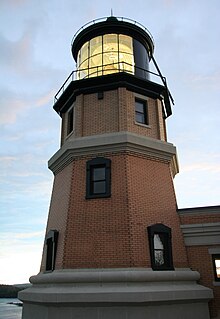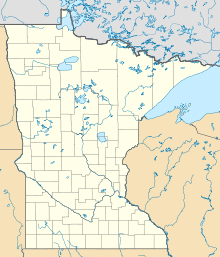Split Rock Light

Split Rock Lighthouse lit at sunset, 2010
|
|
| Location | Split Rock Lighthouse State Park, Beaver Bay Township, Lake County, Minnesota |
|---|---|
| Coordinates | 47°12′00″N 91°22′01″W / 47.20005°N 91.3669°WCoordinates: 47°12′00″N 91°22′01″W / 47.20005°N 91.3669°W |
| Year first lit | 1910 |
| Deactivated | 1969 |
| Foundation | stone |
| Tower shape | Octagonal |
| Height | 54-foot (16 m) tower on a 130-foot (40 m) cliff |
| Original lens | 3rd order, bi-valve type Fresnel lens |
| Range | 22 nautical miles (41 km; 25 mi) |
| Characteristic | 0.5-second flash every 9.5 seconds |
| ARLHS number |
USA-783. |
|
Split Rock Lighthouse
|
|
| Nearest city | Two Harbors, Minnesota |
| NRHP Reference # | 69000073 |
| Significant dates | |
| Added to NRHP | June 23, 1969 |
| Designated NHL | June 23, 2011 |
| Heritage |
national historic landmark of the USA, place listed on the National Register of Historic Places |
|
[]
|
|
USA-783.
Split Rock Lighthouse is a lighthouse located southwest of Silver Bay, Minnesota, USA on the North Shore of Lake Superior. The structure was designed by lighthouse engineer Ralph Russell Tinkham and was completed in 1910 by the United States Lighthouse Service at a cost of $75,000, including the buildings and the land. It is considered one of the most picturesque lighthouses in the United States.
Split Rock Lighthouse was built in response to the great loss of ships during the famous Mataafa Storm of 1905, in which 29 ships were lost on Lake Superior. One of these shipwrecks, the Madeira, is located just north of the lighthouse.
It is built on a 130-foot (40 m) sheer cliff eroded by wave action from a diabase sill containing inclusions of anorthosite. The octagonal building is a steel-framed brick structure with concrete trim on a concrete foundation set into the rock of the cliff. It is topped with a large, steel lantern which features a third order, bi-valve type Fresnel lens manufactured by Barbier, Bernard and Turenne Company in Paris, France. The tower was built for a second order lens, but when construction went over budget, there was only enough funding remaining for the smaller third order lens. The lens floats on a bearing surface of liquid mercury which allows near frictionless operation. The lens is rotated by an elaborate clockwork mechanism that is powered by weights running down the center of the tower which are then reset by cranking them back to the top. When completed, the lighthouse was lit with an incandescent oil vapor lamp that burned kerosene.
At the time of its construction, there were no roads to the area and all building materials and supplies arrived by water and lifted to the top of the cliff by crane. The light was first lit on July 31, 1910. Thanks to its dramatic location, the lighthouse soon became a tourist attraction for sailors and excursion boats. So much so, that in 1924 a road (now Minnesota State Highway 61) was built to allow land access.
...
Wikipedia

